Chao Xu
School of Software, Tianjin University
CREPES-X: Hierarchical Bearing-Distance-Inertial Direct Cooperative Relative Pose Estimation System
Dec 31, 2025Abstract:Relative localization is critical for cooperation in autonomous multi-robot systems. Existing approaches either rely on shared environmental features or inertial assumptions or suffer from non-line-of-sight degradation and outliers in complex environments. Robust and efficient fusion of inter-robot measurements such as bearings, distances, and inertials for tens of robots remains challenging. We present CREPES-X (Cooperative RElative Pose Estimation System with multiple eXtended features), a hierarchical relative localization framework that enhances speed, accuracy, and robustness under challenging conditions, without requiring any global information. CREPES-X starts with a compact hardware design: InfraRed (IR) LEDs, an IR camera, an ultra-wideband module, and an IMU housed in a cube no larger than 6cm on each side. Then CREPES-X implements a two-stage hierarchical estimator to meet different requirements, considering speed, accuracy, and robustness. First, we propose a single-frame relative estimator that provides instant relative poses for multi-robot setups through a closed-form solution and robust bearing outlier rejection. Then a multi-frame relative estimator is designed to offer accurate and robust relative states by exploring IMU pre-integration via robocentric relative kinematics with loosely- and tightly-coupled optimization. Extensive simulations and real-world experiments validate the effectiveness of CREPES-X, showing robustness to up to 90% bearing outliers, proving resilience in challenging conditions, and achieving RMSE of 0.073m and 1.817° in real-world datasets.
Think Before You Move: Latent Motion Reasoning for Text-to-Motion Generation
Dec 30, 2025Abstract:Current state-of-the-art paradigms predominantly treat Text-to-Motion (T2M) generation as a direct translation problem, mapping symbolic language directly to continuous poses. While effective for simple actions, this System 1 approach faces a fundamental theoretical bottleneck we identify as the Semantic-Kinematic Impedance Mismatch: the inherent difficulty of grounding semantically dense, discrete linguistic intent into kinematically dense, high-frequency motion data in a single shot. In this paper, we argue that the solution lies in an architectural shift towards Latent System 2 Reasoning. Drawing inspiration from Hierarchical Motor Control in cognitive science, we propose Latent Motion Reasoning (LMR) that reformulates generation as a two-stage Think-then-Act decision process. Central to LMR is a novel Dual-Granularity Tokenizer that disentangles motion into two distinct manifolds: a compressed, semantically rich Reasoning Latent for planning global topology, and a high-frequency Execution Latent for preserving physical fidelity. By forcing the model to autoregressively reason (plan the coarse trajectory) before it moves (instantiates the frames), we effectively bridge the ineffability gap between language and physics. We demonstrate LMR's versatility by implementing it for two representative baselines: T2M-GPT (discrete) and MotionStreamer (continuous). Extensive experiments show that LMR yields non-trivial improvements in both semantic alignment and physical plausibility, validating that the optimal substrate for motion planning is not natural language, but a learned, motion-aligned concept space. Codes and demos can be found in \hyperlink{https://chenhaoqcdyq.github.io/LMR/}{https://chenhaoqcdyq.github.io/LMR/}
An Anatomy of Vision-Language-Action Models: From Modules to Milestones and Challenges
Dec 19, 2025Abstract:Vision-Language-Action (VLA) models are driving a revolution in robotics, enabling machines to understand instructions and interact with the physical world. This field is exploding with new models and datasets, making it both exciting and challenging to keep pace with. This survey offers a clear and structured guide to the VLA landscape. We design it to follow the natural learning path of a researcher: we start with the basic Modules of any VLA model, trace the history through key Milestones, and then dive deep into the core Challenges that define recent research frontier. Our main contribution is a detailed breakdown of the five biggest challenges in: (1) Representation, (2) Execution, (3) Generalization, (4) Safety, and (5) Dataset and Evaluation. This structure mirrors the developmental roadmap of a generalist agent: establishing the fundamental perception-action loop, scaling capabilities across diverse embodiments and environments, and finally ensuring trustworthy deployment-all supported by the essential data infrastructure. For each of them, we review existing approaches and highlight future opportunities. We position this paper as both a foundational guide for newcomers and a strategic roadmap for experienced researchers, with the dual aim of accelerating learning and inspiring new ideas in embodied intelligence. A live version of this survey, with continuous updates, is maintained on our \href{https://suyuz1.github.io/VLA-Survey-Anatomy/}{project page}.
Simultaneous Classical and Quantum Communications: Recent Progress and Three Challenges
Dec 11, 2025Abstract:A critical aspect of next-generation wireless networks is the integration of quantum communications to guard against quantum computing threats to classical networks. Despite successful experimental demonstrations, integrating quantum communications into the classical infrastructure faces substantial challenges, including high costs, compatibility issues, and extra hardware deployment to accommodate both classical and quantum communication equipment. To mitigate these challenges, we explore novel protocols that enable simultaneous classical and quantum communications, relying on a single set of transceivers to jointly modulate and decode classical and quantum information onto the same signal. Additionally, we emphasize extending quantum communication capabilities beyond traditional optical bands into the terahertz, even possibly to millimeter-wave and microwave frequencies, thereby broadening the potential horizon of quantum-secure applications. Finally, we identify open problems that must be addressed to facilitate practical implementation.
Chemistry-Enhanced Diffusion-Based Framework for Small-to-Large Molecular Conformation Generation
Nov 15, 2025Abstract:Obtaining 3D conformations of realistic polyatomic molecules at the quantum chemistry level remains challenging, and although recent machine learning advances offer promise, predicting large-molecule structures still requires substantial computational effort. Here, we introduce StoL, a diffusion model-based framework that enables rapid and knowledge-free generation of large molecular structures from small-molecule data. Remarkably, StoL assembles molecules in a LEGO-style fashion from scratch, without seeing the target molecules or any structures of comparable size during training. Given a SMILES input, it decomposes the molecule into chemically valid fragments, generates their 3D structures with a diffusion model trained on small molecules, and assembles them into diverse conformations. This fragment-based strategy eliminates the need for large-molecule training data while maintaining high scalability and transferability. By embedding chemical principles into key steps, StoL ensures faster convergence, chemically rational structures, and broad configurational coverage, as confirmed against DFT calculations.
Binary Split Categorical feature with Mean Absolute Error Criteria in CART
Nov 11, 2025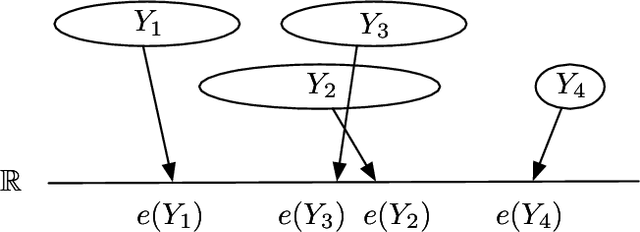

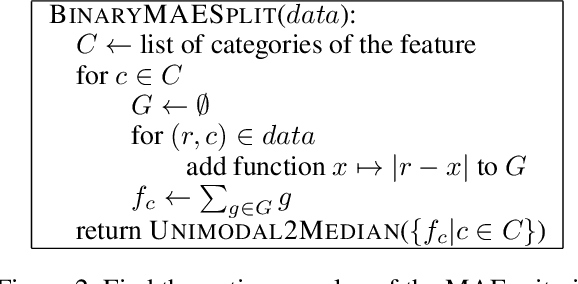
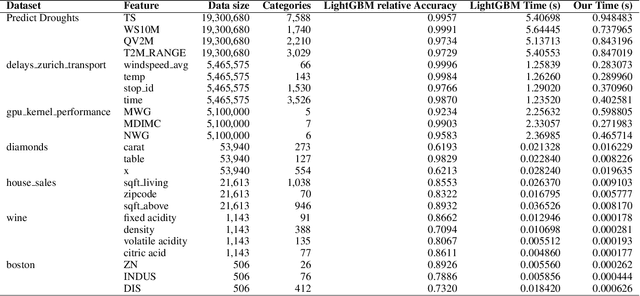
Abstract:In the context of the Classification and Regression Trees (CART) algorithm, the efficient splitting of categorical features using standard criteria like GINI and Entropy is well-established. However, using the Mean Absolute Error (MAE) criterion for categorical features has traditionally relied on various numerical encoding methods. This paper demonstrates that unsupervised numerical encoding methods are not viable for the MAE criteria. Furthermore, we present a novel and efficient splitting algorithm that addresses the challenges of handling categorical features with the MAE criterion. Our findings underscore the limitations of existing approaches and offer a promising solution to enhance the handling of categorical data in CART algorithms.
Language Model Based Text-to-Audio Generation: Anti-Causally Aligned Collaborative Residual Transformers
Oct 06, 2025Abstract:While language models (LMs) paired with residual vector quantization (RVQ) tokenizers have shown promise in text-to-audio (T2A) generation, they still lag behind diffusion-based models by a non-trivial margin. We identify a critical dilemma underpinning this gap: incorporating more RVQ layers improves audio reconstruction fidelity but exceeds the generation capacity of conventional LMs. To address this, we first analyze RVQ dynamics and uncover two key limitations: 1) orthogonality of features across RVQ layers hinders effective LMs training, and 2) descending semantic richness in tokens from deeper RVQ layers exacerbates exposure bias during autoregressive decoding. Based on these insights, we propose Siren, a novel LM-based framework that employs multiple isolated transformers with causal conditioning and anti-causal alignment via reinforcement learning. Extensive experiments demonstrate that Siren outperforms both existing LM-based and diffusion-based T2A systems, achieving state-of-the-art results. By bridging the representational strengths of LMs with the fidelity demands of audio synthesis, our approach repositions LMs as competitive contenders against diffusion models in T2A tasks. Moreover, by aligning audio representations with linguistic structures, Siren facilitates a promising pathway toward unified multi-modal generation frameworks.
MinerU2.5: A Decoupled Vision-Language Model for Efficient High-Resolution Document Parsing
Sep 26, 2025Abstract:We introduce MinerU2.5, a 1.2B-parameter document parsing vision-language model that achieves state-of-the-art recognition accuracy while maintaining exceptional computational efficiency. Our approach employs a coarse-to-fine, two-stage parsing strategy that decouples global layout analysis from local content recognition. In the first stage, the model performs efficient layout analysis on downsampled images to identify structural elements, circumventing the computational overhead of processing high-resolution inputs. In the second stage, guided by the global layout, it performs targeted content recognition on native-resolution crops extracted from the original image, preserving fine-grained details in dense text, complex formulas, and tables. To support this strategy, we developed a comprehensive data engine that generates diverse, large-scale training corpora for both pretraining and fine-tuning. Ultimately, MinerU2.5 demonstrates strong document parsing ability, achieving state-of-the-art performance on multiple benchmarks, surpassing both general-purpose and domain-specific models across various recognition tasks, while maintaining significantly lower computational overhead.
AniME: Adaptive Multi-Agent Planning for Long Animation Generation
Aug 27, 2025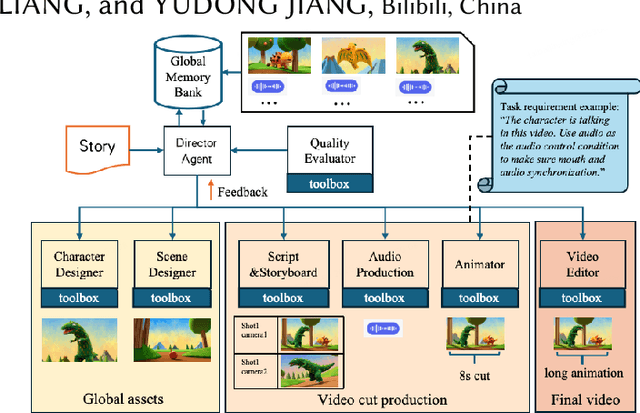

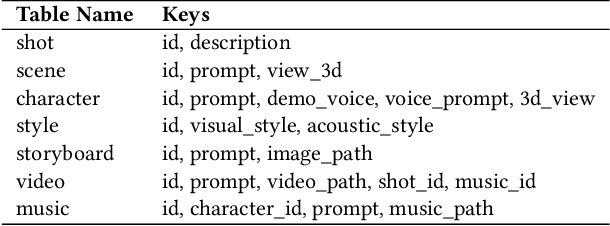
Abstract:We present AniME, a director-oriented multi-agent system for automated long-form anime production, covering the full workflow from a story to the final video. The director agent keeps a global memory for the whole workflow, and coordinates several downstream specialized agents. By integrating customized Model Context Protocol (MCP) with downstream model instruction, the specialized agent adaptively selects control conditions for diverse sub-tasks. AniME produces cinematic animation with consistent characters and synchronized audio visual elements, offering a scalable solution for AI-driven anime creation.
TAR-TVG: Enhancing VLMs with Timestamp Anchor-Constrained Reasoning for Temporal Video Grounding
Aug 11, 2025Abstract:Temporal Video Grounding (TVG) aims to precisely localize video segments corresponding to natural language queries, which is a critical capability for long-form video understanding. Although existing reinforcement learning approaches encourage models to generate reasoning chains before predictions, they fail to explicitly constrain the reasoning process to ensure the quality of the final temporal predictions. To address this limitation, we propose Timestamp Anchor-constrained Reasoning for Temporal Video Grounding (TAR-TVG), a novel framework that introduces timestamp anchors within the reasoning process to enforce explicit supervision to the thought content. These anchors serve as intermediate verification points. More importantly, we require each reasoning step to produce increasingly accurate temporal estimations, thereby ensuring that the reasoning process contributes meaningfully to the final prediction. To address the challenge of low-probability anchor generation in models (e.g., Qwen2.5-VL-3B), we develop an efficient self-distillation training strategy: (1) initial GRPO training to collect 30K high-quality reasoning traces containing multiple timestamp anchors, (2) supervised fine-tuning (SFT) on distilled data, and (3) final GRPO optimization on the SFT-enhanced model. This three-stage training strategy enables robust anchor generation while maintaining reasoning quality. Experiments show that our model achieves state-of-the-art performance while producing interpretable, verifiable reasoning chains with progressively refined temporal estimations.
 Add to Chrome
Add to Chrome Add to Firefox
Add to Firefox Add to Edge
Add to Edge